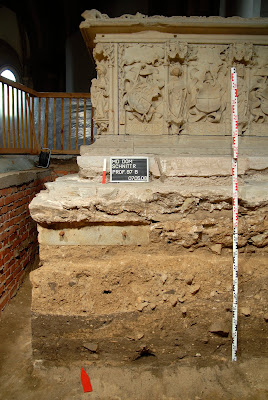 by Kathryn Hadley
by Kathryn Hadley The University of Bristol announced today, January 20th, the recent discovery of the remains of the Saxon Princess Eadgyth, possibly the oldest member of the English royal family whose remains have survived. They were excavated from beneath an elaborate 16th-century monument bearing her name in Magdeburg Cathedral as part of a wider research project into the cathedral.
Eadgyth of Wessex was born in 910. She was the daughter of Edward the Elder, King of Wessex from 900 to 924, and his second wife Aelfflaed and was the granddaughter of Alfred the Great. She was given in marriage to Otto I by her step-brother Athelstan, who was king of Wessex from 929 to 939. Following his victory at the Battle of Brunanburgh in 937, Athelstan later became one of the first kings of a unified England comprising various Saxon and Celtic kingdoms. Otto I, also known as Otto the Great, succeeded his father Henry I as King of Germany in 936. He founded the Ottonian dynasty in Germany and, in 962, was crowned Holy Roman Emperor.
Eadgyth bore Otto at least two children before her death in 946, aged 
However, recent excavations of the tomb at Magdeburg Cathedral, directed by Professor Harald Meller and Dr Veit Dresely of the Landesmuseum fur Vorgeschichte in Saxony Anhalt, revealed a lead coffin bearing Eadgyth's name and recording the transfer of her remains in 1510. Inside the coffin, lay a female skeleton wrapped in silk, aged between 30 and 40.
Small samples from the tomb have been brought back to the University of Bristol for further analysis. A research group from the Department of Archaeology and Anthropology will measure the strontium and oxygen isotopes in the teeth and bone fragments in the hope that they will reveal where Eadgyth grew up and confirm the identity of the corpse.
Professor Mark Horton from the Department of Archaeology and Anthropology explained:
‘We know that Saxon royalty moved around quite a lot, and we hope to match the
isotope results with known locations around Wessex and Mercia, where she could
have spent her childhood. If we can prove this truly is Eadgyth, this will be
one of the most exciting historical discoveries in recent years’.
The findings will be announced at a conference entitled ‘Princess Eadgyth of Wessex and her World’ organised by the Centre of Medieval Studies at the University of Bristol this afternoon. Speakers will also present the current project to analyse the remains and place the discovery in the context of late ninth-century Mercia and Wessex.

For further information on Anglo-Saxon Britain, visit our Anglo-Saxon Britain focus page.
Images (Landesamt fur Denkmalpflege und Archaologie Sachsen-Anhalt, Juraj Liptak):
- the contents of the coffin
- excavation beneath the tomb
- inscription on the side of the sarcophagus, dated 1510
No comments:
Post a Comment